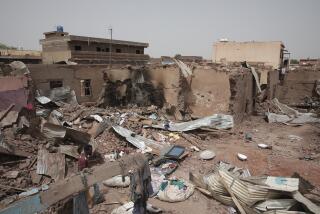U.S. Grows More Generous Toward World’s Poor
- Share via
WASHINGTON — The United States has significantly increased its foreign aid to poor countries but ranks 12th among the 21 richest nations in its overall performance in helping the world’s poor, according to a widely watched annual report released Tuesday.
Denmark ranks as the most generous country in the world, spending 89 cents per person each day in government aid and 1 cent per person each day in private giving, according to the survey by Foreign Policy magazine and the Center for Global Development.
The United States spent 15 cents per person each day in government aid to poor nations and 6 cents per person daily in private giving, the report found. The foreign aid statistics are based on 2003 data, and do not include the outpouring of charity sparked by December’s South Asian tsunami. The United States has pledged $950 million for tsunami relief, part of an estimated $12 billion promised by Western donors.
The Commitment to Development Index attempts to measure how countries help the world’s poor, not only by their direct foreign aid contributions but also their policies on trade, migration, the environment, technology, security and foreign investment.
For example, the index downgrades nations that sell expensive weapons systems to impoverished dictatorships, and it gives points to countries that accept migrants from underdeveloped countries. In calculating aid totals, it subtracts interest payments made by underdeveloped countries to donors.
Japan ranked last among the 21 donors, mainly due to high trade barriers, relatively low per capita foreign aid spending and a poor environmental record in developing countries.
The index has proved controversial in the past. After the tsunami, conservative politicians, activists and others were outraged by suggestions that the U.S. response to the disaster may have been “stingy” and lambasted the foreign aid index and other studies that challenged the notion that the United States was the most generous nation in the world. The U.S. spent more than any other nation on foreign aid in 2003.
Critics argued that such studies do not give the United States credit for the billions it spends in military operations that provide global security and ostensibly allow other nations’ economies to flourish.
Responding to such criticisms, authors of the 2005 index used a revised methodology, said David Roodman, who heads the study at the Center for Global Development, an independent Washington think tank. This year’s report gave the United States points for its military contributions to keeping the world’s sea lanes open for global trade, among other things, Roodman said.
The U.S., the European Union and Canada also were given points for eliminating quotas restricting textile imports from developing nations. But the U.S., Britain and France all lost points as the world’s largest arms merchants, although the United States is selling fewer weapons to undemocratic countries than in the past, Roodman said.
Although the United States spent more than $18 billion in foreign aid in 2003, J. Edward Fox, deputy administrator for the U.S. Agency for International Development, said it was inaccurate to reduce U.S. foreign assistance to dollar terms. Doing so does not reflect the quality of the aid or the variety of ways that the United States helps the developing world, he said.
Not included are $1.2 billion in U.S. food aid to hungry nations, the estimated $34 billion provided each year by the U.S. private sector and the effect of the remittances that migrants working in the United States send to relatives back home, Fox said.
“Throwing money at a developing country is not necessarily the best way to do it,” Fox said.
The index subtracted from the U.S. aid total about $1.5 billion in debt repayment that Washington received from the developing world and about $1 billion in debt that was written off, leaving a net total of $15.8 billion in material foreign aid given in 2003, Roodman said.
Even measured by that stricter standard, however, U.S. aid rose sharply, from $12.4 billion in 2001 and $14.7 billion in 2002, Roodman said, crediting the Bush administration.
The United Nations has called on all nations to give 0.7% of their gross domestic product in foreign aid. U.S. officials reject that standard, noting that it would require a U.S. foreign aid budget of $91 billion per year.
The full report is available at www.cgdev.org/cdi.
*
(BEGIN TEXT OF INFOBOX)
Leading donors
Top ratings on foreign aid from the Commitment to Development Index:
1. Denmark
2. Netherlands
3. Sweden
4. Australia
5. Norway
6. New Zealand
7. Finland
8. Austria
9. Germany
10. Britain
11. Canada
12. U.S.
13. Switzerland
14. Portugal
Ratings are composites of survey criteria for 2003, including per capita spending on foreign aid and policies on trade, technology, migration, security and foreign investment.
Sources: Center for Global Development, Foreign Policy Magazine
More to Read
Sign up for Essential California
The most important California stories and recommendations in your inbox every morning.
You may occasionally receive promotional content from the Los Angeles Times.










